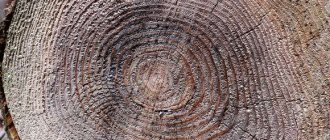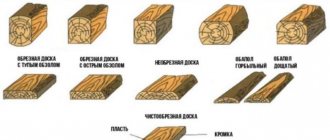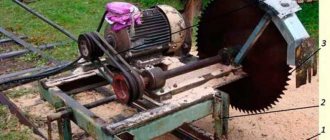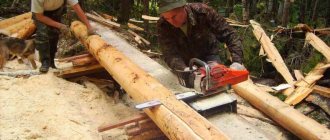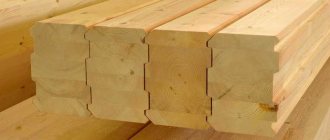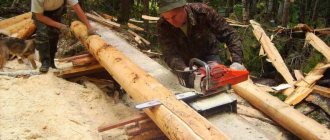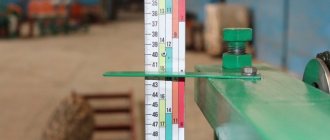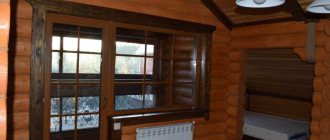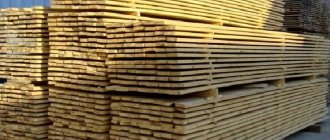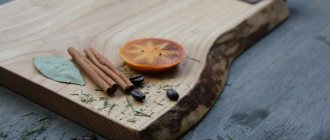Articles
All photos from the article
In this article we will talk about how to cut logs on a band sawmill. In addition, we will consider what are the criteria for selecting one or another method of wood processing and how this affects the characteristics of the finished lumber.
Methods for cutting logs to produce various lumber have been developed and improved for a long time, since this is the only opportunity to obtain edged boards, timber and other categories of similar products from a single tree trunk.
An example of what can be obtained from an ordinary log
From ancient times to the present day, methods of wood processing have evolved, and in addition, new, more productive equipment has appeared that makes it possible to obtain the necessary lumber quickly and with a minimum amount of production waste.
Lumber cutting
Before cutting logs in a band sawmill, preparatory calculations should be made. It is necessary to take into account the direction of the cutting planes, the property of the wood, the number, as well as the volume of the upcoming product.
The variety of material can complicate the problem. For this reason, in order to prevent defects, a diagram of cutting the log trunk is made in advance.
After the log is fixed in the sawmill blade, a calculation is made based on the number of upcoming products.
For this purpose, appropriate measurements are created:
- In thoughts, wood is divided into 4 parts, and any one is also considered separately. A high-quality border is one that is free of damage, mold, chipping, and defects with insects. The best materials are made from it. The bars are often sawed from a plank removed from the worst side of the log.
- In the line of the sawmill, the volume is set to the diameter of the prepared part. The height of the unevenness is added to this value. It involves a difference in diameter among the apex, as well as the butt component.
- Use a tape measure to measure the height of the top of the log. Based on this value, the initial volume of the upcoming materials is calculated, including an allowance for sawing of 2 - 5 millimeters.
- Then, they turn the log 90 degrees, and also create similar calculations.
- The workpiece is unfolded in such a way that when sawing, the minimum number of slabs comes out.
After all the required measurements without exception have been made, and a diagram for cutting the log has been drawn up, it is necessary to decide on the sawing technology.
Types of chainsaw attachments
With the help of special attachments for gasoline tools, you can produce perfectly smooth and suitable lumber. The design of such equipment will consist of several required parts:
- Guide frame. It will move along the surface that needs sawing strictly parallel.
- A vertical stand, which is designed to fasten and hold the mechanism responsible for the thickness of the finished product.
- The thickness adjustment mechanism itself, which is additionally equipped with handles that regulate the thickness fixing screw.
Source master5.ru
Thanks to the presence of a special regulating mechanism, the result of sawing is the same thickness of products with an ideal surface on all sides. Such material will look like it was produced in a factory. You can use two attachment options for longitudinal sawing logs into boards:
- Professional nozzle. This is a special device that can be purchased at hardware stores. If you have a welding machine, a grinder and a metal profile at hand, then such a design can be easily made at home. It should consist of: guide; additional bushing; vice (for clamping the busbar); nuts on M10 with sufficient hardness; studs m10x250 mm.
- Lightweight nozzle. To produce it, you will only need boards with a length equal to the length of the log, boards in height corresponding to the diameter of the log (they will play the role of racks), self-tapping screws and a screwdriver. This structure is constructed in the form of a corner, which is then attached to racks and fixed to the log. The disadvantage of such a guide is that it constantly needs to be unscrewed and moved to a new cutting location.
Source woodweb.com
- Drum debarker. Another convenient device for sawing logs with a chainsaw. The operating principle is to implement clinometer transmission. It must be secured to the belts on both sides using special pulleys. The performance of the nozzle can be easily adjusted due to the size of the pulleys. When using this type of nozzle, you need to carefully monitor the process so that the surface is uniform.
From personal experience! To make it easier to saw a thick log into boards of the same size, I first sawed it in half.
Log cutting methods
Before sawing an entire forest, longitudinal cuts are made along the sides of the log, rarely from absolutely all edges. The released material is used to make double-edged timber, as well as unedged planks.
By changing the direction of the saw in relation to the annual rings in the log, it is possible to purchase timber with a unique pattern.
The properties of such planks will vary. This period is provided for when combining a log cutting scheme.
There are some types of sawing:
- Radial. Sawing is done vertically to the pattern of the rings. The section is valued because it produces a board with a uniform structure, as well as a color palette. It is highly resistant to moisture and shrinkage. This kind of material is high quality.
- Accelerator. Sawing of the log is carried out in parallel, or along the tangent line of relatively annual rings. The boards you buy are of low quality, but they have fascinating images. The materials are susceptible to high moisture and are recommended for use in dry conditions.
- Rustic. The section is made at different angles transversely to the log. The plank includes various imperfections in the form of knots and sapwood. It shows mediocre signs of shrinkage and swelling from moisture.
- Diametrical. The section is made in the middle of the log across the grain. The board has an image of a cross-section of annual rings. It stands out for its low quality.
In order to purchase the maximum number of materials at the lowest cost, it is possible to use special projects, or a drawing of a log cut in a band saw.
Secondly.
As soon as the width of the cut reaches the required size, and the remaining height of the log has reached the desired size, it is turned over. That is, if you cut a beam, for example, at 150, then both the width of the cut and the height of the remaining log should correspond to this value, even be greater, taking into account the removal of the slab.
To do this, after turning the log over, start calculating from the final size until the full height of the log is used, but do not forget to take into account the size of the cut, which, as we already know, ranges from 2 to 5 mm.
For example, you have a log on your overpass that you have cut to a size of 260 mm. Let's turn the log over and continue.
The final result we want to achieve is a carriage with a thickness of 150 mm. Next, in a simple way, calculate that 260 mm-150 mm = 110 mm. We get as much as 110mm of extra material thickness. And it is precisely this that needs to be calculated correctly.
We take this additional size and calculate it to get the block, which has a size of 50 mm, 110-50 = 60, don’t forget the cut, and for us it is 2 mm, 60-2 = 58 mm, then the plank, equal to 25 mm, 58 -25-2=31 mm, hump 20 mm, 31-20-2=9 mm.
As you can see, from our calculations, we get 9 mm slab, 20 mm slab, 25 mm gorge and 50 mm block. And the final size will be 150 mm.
Work organization
At the beginning of the activity, it is recommended to sort the trees, since their direction depends on this. You should clean them of dirt, remove branches, as well as cloves.
The distribution is made according to the following aspects:
- Transverse trunk size;
- Bend;
- Number of knots, various damages;
- Diameter of the core.
Before sawing you should:
- Check the properties of fasteners, as well as combinations of elements.
- Check the presence of electricity.
- Lubricate surfaces subject to rubbing.
- Check the accuracy of the saw designs.
- Check the movement of the belt in idle and in the opposite process.
- If necessary, change the arrow of the sawmill by moving the roller from the left side edge by 5 - 10 cm.
Sawing map
The sawing map is a calculation of the optimal amount of finished lumber from one log. You can calculate it yourself for each specific log diameter, or you can use a computer program that greatly facilitates the calculation, and the price of which is quite affordable.
Or the source could be a regular sawmill reference book. The result is a table that is used as a basis. The sawmill attachment should always be oriented to its data in order to obtain more lumber of any type of wood.
Cutting technology
When selecting a technological process for sawing logs into planks, the properties and scale of the wood are taken into account.
There are 3 methods of activity at the sawmill:
- Sawing into collapse. The wood is sawn along a straight line to the end without any turns. At the exit, unedged planks are purchased. The disadvantage is the low quality of the purchased material, as well as a huge amount of residues. Purchased planks should also be trimmed. During operation there is a significant possibility of their cracking.
- Sawing in a circle. After the first sawing, the log turns to the opposite edge. Typically, there are five reversals. The method makes it possible to cut logs to scale with the least amount of residue. The disadvantages of this method include the low production rate.
- Sawing timber. The main part of sawing a log is done around the circumference. The main part is cut out in the shape of a beam. For this purpose, as a rule, the largest logs are used.
Cutting in a band sawmill is considered one of the most important stages of logging.
The properties of the purchased product directly depend on the chosen scheme, activity, as well as the preparation of the necessary equipment.
Sawing technological map
To calculate the optimal percentage of obtaining finished lumber from logs, a forest sawing map is drawn up. These calculations can be done independently or using a special computer program. Such information can also be obtained in a regular reference book, which contains information on sawmilling operations.
The cutting map allows you to determine how many finished products will be produced and what percentage of waste will be recycled. From these data, you can determine the final cost of the product. The result may largely depend on the type of forest. There are some measures to increase the percentage of lumber yield.
The percentage of lumber at the output is ready-to-use, useful wood. Waste is the raw material for producing MDF, chipboard, and fiberboard. These volumes will depend on the diameter of the tree, the types of solid wood products being manufactured, and the sawing option.
